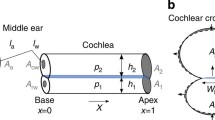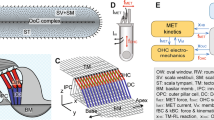Summary
A previously unsuspected mechanical response of the cochlear transduction mechanism has recently been discovered. It can be monitored outside the cochlear. Theoretical and experimental work leading to its discovery and identification are briefly reviewed. Its significance for models of the second filter and cochlear nonlinearity is discussed. An active wave amplification mechanism in the cochlea is proposed.
Similar content being viewed by others
References
Anderson, S. D., Kemp, D. T.: The evoked cochlear mechanical response in laboratory primates. Arch. Otorhinolaryngol. 224, 47–53 (1979a)
Anderson, D. J., Rose, J. E., Hind, J. F.: Temporal position of discharges in single auditory nerve fibres with the cycle of a sine wave discharge. J. Acoust. Soc. Am. 49, 1131–1139 (1971)
Blauert, J. von, Laws, P., Platte, H. J.: Impulsverfahren zur Messung von Außenohrübertragungsfunktionen. Acustica 31, 35–41 (1974)
Elliot, E.: A ripple effect on the audiogram. Nature 181, 1076 (1958)
Gold, T.: Hearing II. The physical basis of the action of the cochlea. Proc. R. Soc. Edinb. B, 135, 492–498 (1948)
Goldstein, J. L.: Auditory Nonlinearity. J. Acoust. Soc. Am. 41, 676–688 (1967)
Kemp, D. T.: Active resonance systems in Audition. 13th International Congress of Audiology, Abstracts 64–65 (1976) (to be published in full)
Kemp, D. T.: Stimulated acoustic emissions from within the human auditory system. J. Acoust. Soc. Am. 64, 1386–1391 (1978a)
Kemp, D. T.: Resonances originating within the cochlea, presented to the British Society of Audiology meeting, Keele University, April 1978b. J. Brit. Soc. Audiol. (in press)
Kemp, D. T.: The evoked cochlea mechanical response and cochlear resonances. J. Acoust. Soc. Am. (submitted)
Kemp, D. T.: The evoked cochlear mechanical response and the auditory microstructure — Evidence for a new element in cochlear mechanics. Scand. Audiol. [Supplement on Models of the auditory system] (in press) (1979b)
Kim, D. O., Siegel, J. H., Molnar, C. E.: Cochlear nonlinear phenomena in two tone responses. Scand. Audiol. [Supplement on Models of the auditory system] (in press) (1979)
Kim, D. O., Molnar, C. E., Pfeiffer, R. R.: A system of nonlinear differential equations modelling basilar membrane motion. J. Acoust. Soc. Am. 54, 1517–1529 (1973)
Rhode, W. S., Robles, L.: Evidence from Mossbauer experiments for nonlinear vibration in the cochlea. J. Acoust. Soc. Am. 55, 588–596 (1974)
Thomas, I. B.: Microstructure of the pure tone threshold, J. Acoust. Soc. Am. 57 (Abstract supplement) 26–27 (1975)
Van den Brink, G.: Frequency analysis and periodicity detection in hearing. p. 362–374. Leiden: Sythoff 1970
Wilson, J. P., Johnstone, J. R.: Basilar membrane and middle ear vibration in guinea pig measured by capacitive probe. J. Acoust. Soc. Am. 57, 705–723 (1975)
Author information
Authors and Affiliations
Additional information
This work is supported by a grant from the Medical Research Council
Rights and permissions
About this article
Cite this article
Kemp, D.T. Evidence of mechanical nonlinearity and frequency selective wave amplification in the cochlea. Arch Otorhinolaryngol 224, 37–45 (1979). https://doi.org/10.1007/BF00455222
Issue Date:
DOI: https://doi.org/10.1007/BF00455222




